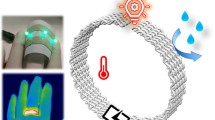Abstract
The number of application fields of micro systems and microelectronic components is increasing continuously. International fairs clearly show smaller and compact circuits on foil substrates. Especially, the sensoric and actuatoric sensor systems become more flexible. However, nonrigid and extremely loadable and bendable systems may only be manufactured from textiles. The galvanic and electrochemical finishing of textiles is one way to build textile-based micro systems. A concept for the production of electrically highly conductive, functionalized, and interactive yarns is proposed. The first step of the concept, the highly conducting yarns, are already transferred into an industrialized production and are commercially available. Silver-coated polyamide yarns are already on the market since the end of the 1970s. Till now, the applications have been limited on the use of their anti-electrostatic and antimicrobic properties. The drawbacks of the yarns can be overcome by an electrochemical treatment to increase the metal layer and to create multilayer systems or functional top layers by anodization and other electrochemical techniques like the electro-polymerization and electro-deposition of paint. The treated yarns can be processed by any textile technology. Especially, the metal oxide layers of valve metals and the redox polymer layers are highly interesting due to their semiconducting properties. The surface treatment can be understood as a novel kind of textile finishing. In this way, high conductivity, nano-functionalized surfaces by electro-grafting and special redox-properties for an interactive release of drugs are available. First applications (electroluminescenting fabrics, woven electronic circuits, microelectronic devices as for example textile antennas, capacitors, solar cells and even interactive textiles for the controlled release of drugs) will be demonstrated in this contribution.













Similar content being viewed by others
References
Information on http://www.research.philips.com/newscenter/archive/2005/050902-phottext.html (Philips Research Press Information, September 2, 2005, Philips demonstrates photonic textiles that turn fabric into intelligent displays), Information on www.imbut.de, Information on www.statex.de
Möhring U, Neudeck A, Scheibner W (2006) Textile micro system technology. In: Mattila H (ed) Intelligent textiles and clothing. Woodhead Publishing Limited, Cambridge
Tao XM (ed) (2001) Smart fibres, fabrics and clothing: fundamentals and applications. Woodhead Publishing Limited, Cambridge
Cherenack K, van Pieterson L (2012) Smart textiles: challenges and opportunities. J Appl Phys 112:091301
Gimpel G, Möhring U, Müller H, Neudeck A, Scheibner W (2003) Galvanische und elektrochemische Modifizierung von Textilien zur Integration von Mikrosystemtechnik, Sensorfunktionen und Elektrolumineszenz. Melliand Band Flechtindustrie 40/4:115
Adenier A, Combellas C, Kanoufi F, Pinson J, Podvorica FI (2006) Formation of polyphenylene films on metal electrodes by electrochemical reduction of benzenediazonium salts. J Am Chem Soc 18:2021–2029
von Krshiwoblozki M, Linz T, Neudeck A, Kallmayer C (2013) Electronics in textiles—adhesive bonding technology for reliably embedding electronic modules into textile circuits. Adv Sci Technol 85:1–10
Information on http://www.bekaert.com/en/Product%20Catalog/Products/B/Bekinox%20conductive%20fibre%20based%20-%20filament%20based%20products%20for%20anti-static%20textile%20applications.aspx (NV Bekaert SA Headquarters, Kortrijk, Belgium)
Information on http://www.zimsi.com/web/zimmermann.nsf/id/pa_novonic.html?OpenDocument&vCMSTemplate=geiger (W. Zimmermann GmbH & Co. KG, Weiler-Simmerberg, Germany)
Information on http://www.smartfiber.de/deutsch/index.php?option=com_content&view=article&id=40&Itemid=87 (Smartfiber AG, Rudolstadt, Germany)
Information on http://www.grafe.com/grafeinnovation.html (GRAFE Advanced Polymers GmbH, Blankenhain, Germany)
Perera R (2012) Innovative smart materials for wearable electronics. Proceeding of the 4th International Conference Smart Materials Structures, Systems–CIMTEC, Montecatini Terme, Section D
Compton RG, Eklund JC, Marken F, Rebbitt TO, Akkermans RP, Waller DN (1997) Dual activation: coupling ultrasound to electrochemistry—an overview. Electrochim Acta 42:2919–2927
Information on http://www.tu-chemnitz.de/mb/lvw/forschung/LA1274.php (Chemisch und galvanisch abgeschiedene Nanokomposite für die Mikrosystemtechnik. Granded project by BMBF, LA 1274/10-1)
Neudeck A, Zimmermann Z, Hellwich H, Hacke A, Möhring U (2006) Technologie zur galvanischen und elektrochemischen Modifizierung von vorstrukturierten partiell leitfähigen textilen Flächen. Unitex 2:12–14
Information on http://www.vdivde-it.de/mst-textil/statusmeeting-2012, KorTeSo granded BMBF project MST 16SV4043
Neudeck A, Modes A, Krahmer A, Hartmann U, Weiser M, Armbruster B, Möhring U (2012) Analyse der Wärmeverteilung bei C-CVD-Prozessen an Garnen. Proceedings of the Thementage Grenz- und Oberflächentechnik, Leipzig
Acknowledgments
The authors would like to thank the Federal Ministry of Education & Research (BMBF) of Germany, and the VDI/VDE-IT for funding parts of this work in the frame of the projects Texoled MST 16SV3450, Lumoled MST 16SV4041, TexSolar MST 16SV3456, KorTeSo MST 16SV4043 and TePat MST 16SV4045, the Thuringian Ministry of Economy, Technology and Labour (TMWAT) for funding the project “interactive textile TTS” 2004WF0115, the Federal Ministry of Economy (BMWi) for founding “textile electroosmosis” AB_VF090011 and “textile waterelectrolysis” VF 120010 in the frame of the Inno Komm Ost Founding, as well as the European Commission for funding parts of this work under contract FP7-ICT-248048 (PLACE-it project).
Author information
Authors and Affiliations
Corresponding author
Rights and permissions
About this article
Cite this article
Neudeck, A., Zimmermann, Y. & Möhring, U. Textile electrochemistry—from the conducting yarn via sensoric and interactive structures to robust and flexible textile micro systems and technical applications. J Solid State Electrochem 19, 3–12 (2015). https://doi.org/10.1007/s10008-014-2607-8
Received:
Revised:
Accepted:
Published:
Issue Date:
DOI: https://doi.org/10.1007/s10008-014-2607-8




